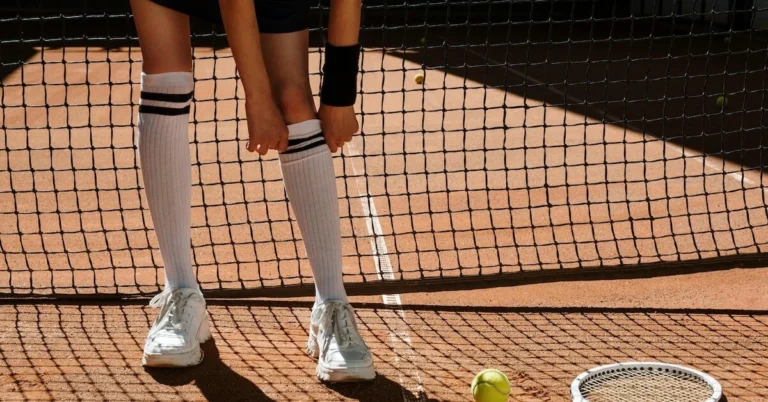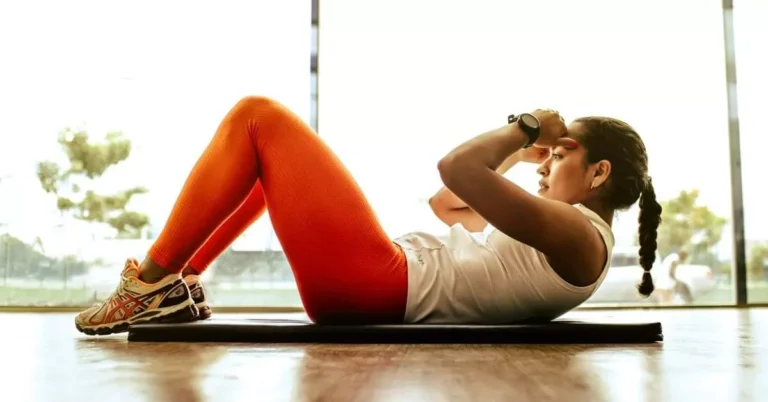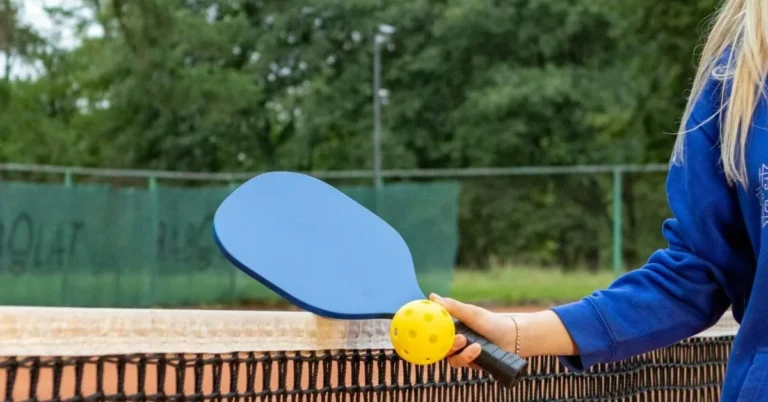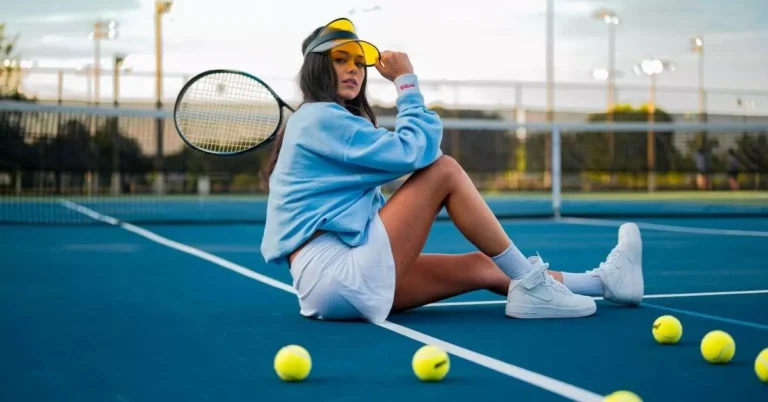Tennis court positioning is an essential aspect of the game that can make all the difference in winning or losing a match. It involves knowing where to stand on the court to maximize your chances of reaching your opponent’s shots and returning them effectively. Understanding tennis court positioning can help you become a more efficient and strategic player, and improve your overall game.
In this article, we will explore the various aspects of tennis court positioning, including the different shots and strategies involved, positioning based on opponent’s play, footwork and recovery position, and singles and doubles positioning. We will also provide tips and techniques to help you improve your tennis court positioning and become a more effective player. Whether you are a beginner or an experienced player, this article will provide valuable insights into the game of tennis and help you take your game to the next level.
Understanding Tennis Court Positioning
Tennis court positioning is a complex and dynamic aspect of the game that requires knowledge and information to master. By understanding the basics of tennis court positioning and implementing dynamic court positioning strategies, you can improve your game and outmaneuver your opponents.
Basics of Court Positioning
The first step in understanding tennis court positioning is to familiarize yourself with the different areas of the tennis court. The court is divided into two halves by the net, with each half being further divided into three sections: the baseline, the service line, and the net.
The baseline is the furthest point from the net and is where most of the rallies take place. The service line is located halfway between the baseline and the net, and this is where players serve from. The net is the dividing line between the two halves of the court.
When playing tennis, it is important to position yourself in a way that allows you to cover as much of the court as possible while still being able to quickly move to where the ball is going. Generally, players will position themselves closer to the net when they are on the offensive and closer to the baseline when they are on the defensive.
Dynamic Court Positioning
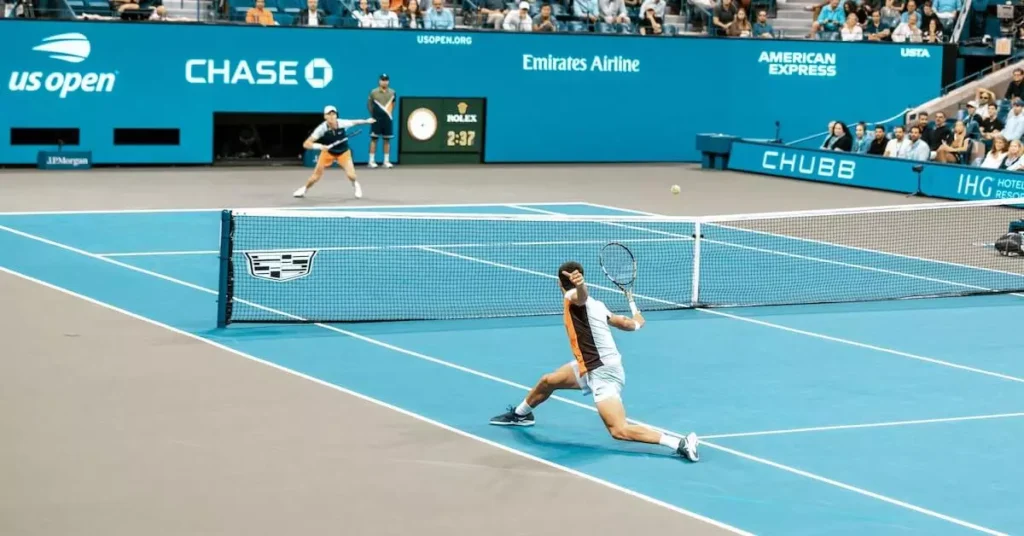
While the basics of tennis court positioning are important, it is also crucial to be able to adapt your positioning based on the situation. This is where dynamic court positioning comes into play.
Dynamic court positioning involves constantly adjusting your position on the court based on the movements of your opponent and the trajectory of the ball. By doing this, you can anticipate where the ball is going and position yourself in a way that allows you to hit the ball back with ease.
One key aspect of dynamic court positioning is footwork. By having quick and precise footwork, you can move around the court more efficiently and position yourself in a way that allows you to hit the ball back with power and accuracy.
Importance of Tennis Court Positioning
Good tennis court positioning is essential. It gives you the ability to move around the court quickly and efficiently, and it allows you to be in the best possible position to hit your shots. Here are a few reasons why tennis court positioning is so important:
Power and Control
When you’re in the right position on the court, you can generate more power in your shots. This is because you’re able to use your body weight and momentum to your advantage. You’re also able to hit the ball with more control, which means you’re less likely to make unforced errors.
Pressure and Reaction Time
Good tennis court positioning puts pressure on your opponent. When you’re in the right position, you can cover more of the court, which makes it harder for your opponent to hit winners. This means they’ll have to hit more shots, which increases the chances that they’ll make an error. Good tennis court positioning also gives you more time to react to your opponent’s shots, which means you’ll be able to get to more balls and hit better shots.
Here are a 4 tips to help you improve your tennis court positioning:
- Stay on the balls of your feet so you’re ready to move in any direction.
- Keep your eyes on the ball at all times so you can anticipate where it’s going.
- Move towards the center of the court after hitting your shot so you’re in a good position to cover the next shot.
- Practice moving around the court in a variety of different situations so you’re comfortable in any position.
By following these tips and focusing on your tennis court positioning, you’ll be able to improve your game and take your tennis skills to the next level.
Tennis Shots and Court Positioning

Tennis court positioning is not just about where you stand on the court, it’s also about the shots you make. In this section, we’ll cover the three main types of tennis shots and how they relate to tennis court positioning.
Groundstrokes
Groundstrokes are the most common shots in tennis. They are executed by hitting the ball after it has bounced on the court. When it comes to tennis court positioning, your position will depend on the type of groundstroke you are making. For example, if you are hitting a forehand groundstroke, you will want to position yourself on the opposite side of the court from your opponent. This will give you the best angle to hit the ball with topspin and send it back to your opponent with power.
Volleys
Volleys are shots that are hit before the ball bounces on the court. They require quick reflexes and good tennis court positioning. When it comes to volleys, your position will depend on where your opponent is hitting the ball. If they are hitting the ball to your left, you will want to position yourself on the right side of the court. This will give you the best chance to hit the ball back with accuracy and power.
Lob Shots
Lob shots are high arcing shots that are used to get the ball over your opponent’s head. They are a great way to change the pace of the game and catch your opponent off guard. When it comes to tennis court positioning, you will want to position yourself closer to the net when hitting a lob shot. This will give you the best angle to hit the ball high and over your opponent’s head.
Positioning Based on Opponent’s Play
When it comes to tennis court positioning, it’s important to consider your opponent’s play style. By analyzing their tendencies, you can position yourself in a way that will give you the best chance of success. Here are some tips on how to position yourself based on your opponent’s play style.
Aggressive Play
If your opponent is an aggressive player who likes to hit winners and take control of the point, you should position yourself further back from the baseline. This will give you more time to react to their shots and set up your own. It’s also important to be prepared to move forward and attack when the opportunity presents itself. By being patient and waiting for the right moment, you can take advantage of their aggression and turn the tables on them.
Net Player

If your opponent is a net player who likes to move forward and take control of the net, you should position yourself closer to the baseline. This will give you more time to react to their shots and keep them from getting too close to the net. It’s also important to be prepared to hit a variety of shots, including lobs and passing shots, to keep them off balance and prevent them from getting comfortable at the net.
Service Box and the V
Positioning in the Service Box
When serving in tennis, the service box is a designated rectangular area on the court where the server must aim their serves. There are two service boxes, one on each side of the net, positioned diagonally from each other. The service box is marked by lines, including the singles sideline, center mark, and baseline. The service box is 21 feet long and 13.5 feet wide, with the center service lines dividing it into two equal parts.
The ideal positioning in the service box is to stand behind the baseline and align your front foot with the center mark. This will give you the best angle to serve the ball into the opposite service box. When serving from the right-hand side of the court, your left foot should be forward, and when serving from the left-hand side, your right foot should be forward.
Utilizing the V
The V is the area of the court that is formed by the intersection of the service line and the center line. The V is a strategic area that can be utilized by both the server and the receiver.
For the server, hitting the ball into the V will give them a better chance of hitting an ace or forcing a weak return. Hitting the ball into the V will also give the server a better angle to hit their next shot, as it will pull the receiver out of position.
For the receiver, standing in the V will give them the best chance of returning the serve. By standing in the V, the receiver will be able to cover more of the court and have more time to react to the serve.
In doubles, the net player can also utilize the V by standing close to the net and intercepting any weak returns that land in the V.
Footwork and Recovery Position
Importance of Footwork
Footwork is one of the most important aspects of tennis court positioning. It involves how you move your feet to get to the ball and how you position yourself to hit the ball. Good footwork allows you to get to the ball quickly and efficiently, which is crucial in tennis.
Having good footwork also helps you maintain balance, which is essential for hitting accurate shots. When you move your feet correctly, you can transfer your weight from one foot to the other, allowing you to hit the ball with more power and control. Practicing footwork drills can improve your balance and help you move more efficiently on the court.
Recovery Position
Recovery position is the position you move to after hitting a shot. It is also known as the ready position, and it is crucial for good court coverage. The recovery position helps you get back to the center of the court quickly, allowing you to be ready for your opponent’s next shot.
To get into the recovery position, you should move towards the center of the court, with your feet shoulder-width apart and your knees slightly bent. Your weight should be evenly distributed on both feet, and your body should be facing the net. This position allows you to move in any direction quickly and efficiently.
Practicing the recovery position is essential for good court coverage. You should practice moving to the recovery position after every shot, whether it’s a forehand, backhand, or volley. This will help you develop the muscle memory required to move quickly and efficiently on the court.
Positioning in Singles and Doubles

When it comes to tennis, positioning is crucial for both singles and doubles play. Proper positioning allows you to cover the court effectively and consistently, giving you a better chance of winning the point. In this section, we’ll discuss the different aspects of positioning in both singles and doubles play.
Singles Sideline
In singles play, the sideline is an important factor to consider when positioning yourself. You want to position yourself in a way that allows you to cover as much of the court as possible, while still being able to move quickly to return shots. Here are a few tips for positioning yourself on the singles sideline:
- Stand about one to two feet inside the baseline to give yourself more time to react to incoming shots.
- Position yourself slightly to the side of the center mark to give yourself a better angle for returning cross-court shots.
- Move closer to the sideline when your opponent hits a short ball, and move towards the center of the court when your opponent hits a deep ball.
Doubles Play
In doubles play, positioning is even more important because you’re playing with a partner. You need to work together to cover the court effectively and consistently. Here are a few tips for doubles positioning:
- Decide on a formation with your partner before the match begins. Common formations include the “I” formation and the “Australian” formation.
- Communicate with your partner throughout the match to ensure you’re both in the right position to cover the court.
- In general, the player at the net should be more aggressive and take more risks, while the player at the baseline should focus on consistency and keeping the ball in play.
If you want to learn more about tennis doubles, you can read our article: Tennis Double Strategy for Beginners.
Exploring Strategies for Court Positioning
Tennis court positioning plays a crucial role in determining the outcome of a match. By positioning yourself correctly, you can cover more ground and be in a better position to return your opponent’s shots. In this section, we’ll explore some strategies for tennis court positioning that can help you improve your game.
Beginner Strategies
If you’re new to tennis, it’s important to start with the basics. Here are some beginner strategies for tennis court positioning:
- Stay behind the baseline: When you’re starting out, it’s best to stay behind the baseline. This gives you more time to react to your opponent’s shots and adjust your position accordingly.
- Move side-to-side: As you get more comfortable, start moving side-to-side to cover more ground. This will help you get to shots that you might have missed otherwise.
- Watch your opponent: Pay attention to your opponent’s body position and shot selection. This can give you clues about where they’re likely to hit the ball next, allowing you to position yourself more effectively.
Advanced Strategies
Once you’ve mastered the basics, it’s time to move on to more advanced strategies. Here are some tips for advanced tennis court positioning:
- Explore different positions: Don’t be afraid to experiment with different positions on the court. For example, moving closer to the net can help you take advantage of your opponent’s weak shots, while staying back can give you more time to react to powerful shots.
- Use spin and pace: Varying the spin and pace of your shots can help you control the pace of the game and keep your opponent off balance. This can also help you position yourself more effectively.
- Pay attention to the ads: In doubles matches, it’s important to pay attention to the position of the ads. If you’re on the ad side, you’ll want to position yourself closer to the center of the court to cover more ground.
By following these strategies, you can improve your court positioning and take your game to the next level. Remember to stay focused, stay flexible, and keep exploring new strategies to find what works best for you.
FAQ
What is tennis court positioning?
Tennis court positioning refers to the placement of the player on the court during a point. It is critical to have good court positioning as it allows you to reach your opponent’s shots as quickly as possible. Proper positioning also helps you cover more of the court, making it harder for your opponent to hit winners.
How can I improve my tennis court position?
One way to improve your tennis court position is to practice footwork drills. These drills can help you move quickly and efficiently around the court. You can also work on your court positioning by focusing on your split-step. The split-step is a small hop that you take just before your opponent makes contact with the ball. This hop helps you prepare to move in any direction quickly.
Where not to stand in tennis?
You should avoid standing too close to the net or too far behind the baseline. Standing too close to the net can leave you vulnerable to passing shots, while standing too far behind the baseline can make it difficult to hit aggressive shots.
Where should you stand when playing tennis?
The best place to stand in tennis depends on a few factors, including your opponent’s position, the type of shot they are hitting, and your own strengths and weaknesses. As a general rule, you should aim to stand in the center of the court, just behind the baseline. This position allows you to cover the most ground and gives you the best chance of reaching your opponent’s shots.
Can you stand anywhere in tennis?
No, you cannot stand anywhere in tennis. There are specific areas on the court where you are allowed to stand. You must stand behind the baseline when serving, and you must stay inside the lines of the court during play. If you step outside of the lines, the ball is considered out of play.
Should your stance be open or closed in tennis?
Your stance in tennis depends on the type of shot you are hitting. For groundstrokes, a closed stance is typically used for more power, while an open stance is used for better court coverage. For volleys, a closed stance is typically used for more control, while an open stance is used for better reach.
We’re curious about your experience with tennis court positioning. What techniques or strategies have you found most effective for optimal court coverage? Share your insights and tips in the comments below and let’s help each other master the art of court positioning in tennis!



